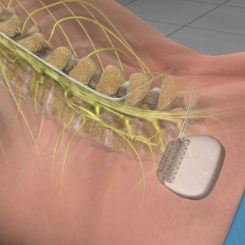If chronic pain doesn’t subside with conservative treatments, spinal cord stimulation may be the solution you’ve been searching for. At Restore Health in Spokane and Richland, Washington, their team offers spinal cord stimulation to reduce pain signals sent from your nerves to your brain for long-lasting relief. Schedule an appointment with Restore Health by calling the office nearest you or booking online today.

Spinal Cord Stimulation FAQ’s
Spinal cord stimulation is a treatment for chronic pain that diminishes pain signals to your brain. A device that’s similar to a pacemaker delivers electrical impulses to your spinal cord to alter pain signals for relief so that you can reduce or avoid addictive pain medicines.
Your pain specialist might recommend spinal cord stimulation if conservative treatments haven’t worked, and you suffer from:
- Back, leg, or arm pain
- Sciatica
- Post-surgical pain
- Heart pain
- Spinal cord injuries
- Nerve pain
- Complex regional pain syndrome
- Pain after amputation
- Chronic abdominal pain
- Other forms of chronic pain
Your Restore Health provider might recommend spinal cord stimulation in addition to other treatments to help you achieve long-lasting relief.
To determine if spinal cord stimulation is right for you, your pain management specialist reviews your symptoms and medical history. They may use blood tests or imaging procedures, such as X-rays, MRIs, or CT scans, to find the root cause of your discomfort.
The first step in spinal cord stimulation is receiving a trial spinal cord stimulator. Your physician inserts electrodes into your spine, but the stimulator device remains outside of your body. You wear the device on a belt around your waist for about a week. If spinal cord stimulation is effective, you can schedule surgery for permanent spinal cord stimulator implantation.
During the second procedure, you’re given local anesthesia and sedation, so you don’t feel any pain. Your surgeon implants a generator underneath your skin. They use fluoroscopy to place electrodes within your spine and close the incision site.
You can go home the same day as your surgery, but you must have someone drive you home. Follow your doctor’s post-surgery instructions. The incision site might be sore for a few days. The treatment area usually heals within a few weeks.
Avoid strenuous physical activity for about two weeks, or until your surgeon gives you the okay, and attend follow-up appointments as instructed by your doctor.
Don’t live with chronic pain when minimally invasive solutions are within reach at Restore Health. Schedule an appointment by phone or book online to determine if spinal cord stimulation is right for you.
